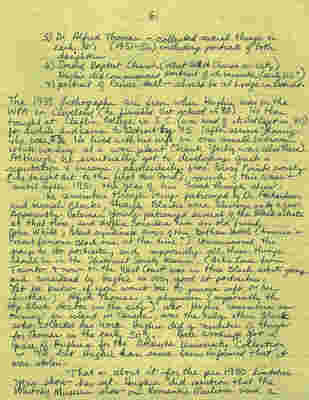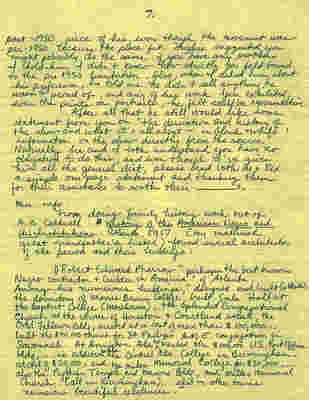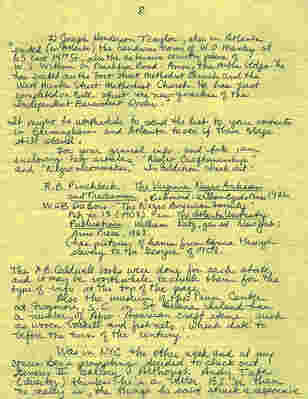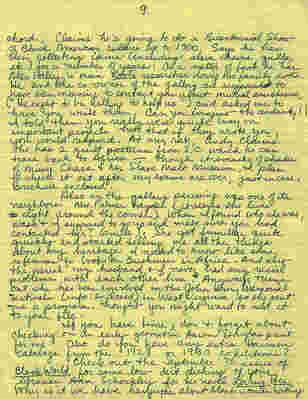Pages
36
6.
5) Dr. Alfred Thomas - collected several things in early 50's (1951-56) including portraits of both daughters 6) Second Babtist Church (oldest Black Church in city) Hughie did commissioned portrait of its minister (early 50's?) 7) portrait of Prince Hall - should be at Lodge in Detroit. The 1938 Lithographs are from when Hughie was on the WPA in Cleveland (he finished Art school in '38). He then taught at Claflin College in S.C. (was head of its Art Dept in '40). for awhile and came to Detroit by '45 [after service?) during the war. He lived with his wife in one small bedroom while working at a war plant (Frank Yerly was also there). Although he eventually got to developing quite a reputation & income, particularly from Gross Pointe society (he taught art to the first Mrs. Ford), much of this wasn't until after 1951, the year of his break through show. He remembers though being patronized by Dr. Richardson and several Blacks, though Blacks were always only a few. Apparently Coleman Young patronized several of the Black artists at that time, and Hughie considers him an old friend. John White, Black syndicate owner of the Gotham Hotel (America's most famous Black one at the time?) commissioned the group to do portraits, and supposedly all these things should be in the Historical Society Museum. (Artis Lane from Toronto & now on the West Coast was in this Black Artists group and considered by Hughie as very good at portraiture. Let me know if you want me to pursue info on her further.) Alfred Thomas, a physician (supposedly the top Black doctor in the city) who Hughie remembers as owning an island in Canada, was the only other Black who collected his work. Hughie did a number of things for Thomas in the early 50's. Hale Woodruff got a piece of Hughie's for the Atlanta University Collection in '43 but Hughie has since been informed that it was stolen. That's about it for the pre 1950 limitation your show has set. Hughie did mention that the Whitney Museum show on Romantic Realism used a
37
7.
post - 1950 piece of his, even though the movement was pre - 1950, because the piece fit. Hughie suggested you might possibly do the same if you have any problems. I told him I didn't know how strictly you felt bound to the pre 1950 limitation. Also, when I asked him about his preference, he told me he didn't sell anything he wasn't proud of, and any of his work you exhibited, even the prints or portraits, he felt would be representative. After all that he still would like some statement from you on "the derivation and history of the show and what it's all about - in Black & white : information on the show directly from the source." Naturally he and I both understand you have no obligation to do this, and even though I've given him all the general dirt, please send both he & Rex a simple one page statement and thanking them for their assistance to sooth their _____s.
Misc. info: From doing family history work out of A.B. Caldwell History of the American Negro and His Institutions. Atlanta. 1917. (my maternal great grandfather's listed) found several architects of the period and their buildings:
1) Robert Edward Pharrow "perhaps the best known Negro contractor & builder in America" of Atlanta. Among his numerous buildigs, "designed and built (in Atlanta) the dormitory of Morris Brown College, built Sale Hall at the Baptist College (Morehouse), the splendid Congregational Church at the corner of Houston & Courtland streets, the Odd Fellows Bldg, erected at a cost of more than $100,000... built the $40,000 church for St Philips A.M.E. congregation in Savannah. At Anniston, Ala he erected the $100,000 U.S. Post Office bldg,... in addition in Ala. the Central Ala. College in Birmingham at cost of $25,000, and the Miles Memorial College for $30,000... also the Pythian Temple, and Mason's Bldg, and Miller Memorial Church (all in Birmingham). also in other towns numerous beautiful residences."
38
8.
2) Joseph Henderson Traylor, also in Atlanta "erected (in Atlanta) the handsome home of W.D. Manley at 65 East 14th St, also the extensive country place of W.S. Witham on Peachtree Road. Among the public bldgs he has erected are the Fort Street Methodest Church and the West Hunter Street Methodist Church. He has just completed on Bell street the new quarters of the Independent Benevolent Order."
It might be worthwhile to send the list to your contacts in Birmingham and Atlanta to see if these Bldgs still stand. For your general info and file, am enclosing two articles: "Negro Craftsmanship" and "Negro Ironmaker." In addition check out:
R.B. Pinchbeck. The Virginia Negro Artisan and Tradesman. Richmond: William Byrd's Press 1926. W.EB DuBois. "The Negro American Family" Pub. no. 13. (1908). in The Atlanta University Publications. William Katz. gen ed. New York; Arno Press, 1968. (has pictures of homes from Africa through slavery to the Georgia of 1908.
The A.B. Caldwell books were done for each state and it may be worthwhile to check them for the type of info at the top of the page. Also the museum of the Penn Center at Frogmore, S.C. on St. Helena Island has a number of Afro-American craft items, such as woven baskets and fish nets, which date to before the turn of the century.
Was in NYC the other week and at my cousin Ben's prompting decided to check out Genesis II Gallery. Although Andy Tate (director) thinks he's a better BS.'er than he really is, the things he said struck a responsive
39
9.
chord. Claims he's going to do a Bicentennial Show of Black American culture up to 1900. Says he has been collecting items (including slave chains, quilts, etc.) for a number of years. As a matter of fact, he has Alex Haley's main Roots researcher doing his family roots. He and the co-owner of the gallery are supposed to have been meaning to contact you about mutual assistance, ("He ought to be willing to help us.") and asked me to have you write them. Can you imagine - the audacity!! I told them you really were quite busy on important projects but that if they wrote you, you would respond. At any rate, Andy claims he has 2 quilt patterns from S.C. which he can trace back to Africa - though it smacks of shades of Missy Chase & her Slave Mart Museum, I plan to check it out after my exams are over, just in case. Brochure enclosed. Also in the gallery perusing was one of its neighbors Mrs. Palmer Hayden. (it seems she lives right around the corner). When I found who she was, wasn't I supposed to go up and make sure you had contacted her? (smile). She got familiar quite quickly and started telling me all the things about my heritage I needed to know like some references to books on Bushmen in Africa. And also the usual "my husband & I never had any racial problems with each other" line. Anyway, turns out she has been involved in the John Henry Memorial Festivals (info. enclosed) in West Virginia so she sent me a program. Thought you might want to add it to your file. If you have time, don't forget about checking on an early geometric Aaron Douglas print for me. Also do you have any extra Harmon catalogs from the 1928 or 1930 exhibitions? Check out the September '75 issue of Black World for some low dirt dishing of your librarian Ann Schockley for her novel Loving Her. Why is it we have hangups about Black women hating
40
10.
Black men and loving and worshiping what they think is between white women's legs? (sic)
Misc. Ramblings: Richard Long has an early (30's?) Catlett drawing in his bedroom. I think the L.A. catalog should have as many illustrations as possible - more than the 25 pages you mention in the proposal and of at least 50% of the items in the show. Have you expanded the dates past 1950? I saw Hooks, Hunt, & Chase-Riboud names listed in the proposal under sculpture and of course I wonder how anyone born after 1925 would otherwise get in. Are you going to photograph all the pieces in the show? - you should. This could be the start of a permanent photo file for somewhere in the country, maybe the DuSable Museum - sort of our answer to Princeton's Index of Christian Art. Fantasizing a bit, eventually it might be expanded to include a computer storage file on the condition, location, size, media, etc. of all Black art in the country. I was pleasantly surprised to find Thelma reacting so positively to me! I just don't know what I did that was unusual or out of the ordinary. When you come this way let's plan to see John Rhoden. I'd really like that. Thanks for the exam well wishes. I needed that. Look to hear from you and see you in the near future. Steve. P.S. Don't tell nobody, but I'm told somebody put all of somebody's business out in the street in the Sept 8, 1975 issue of Time. Just why. Jesus?






